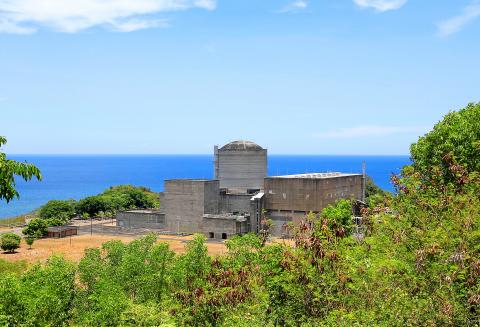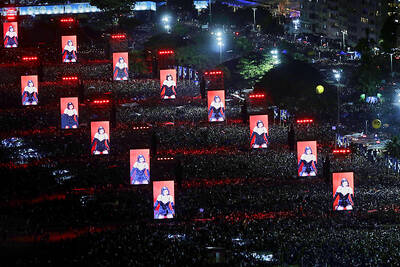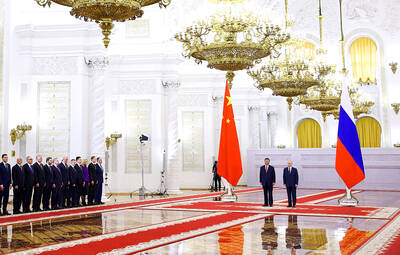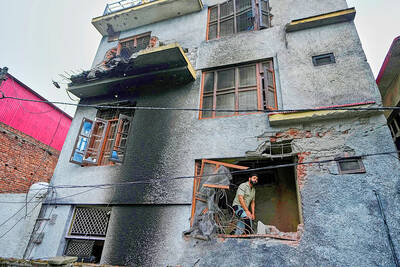Wilfredo Torres was hired as a technician for Southeast Asia’s only nuclear power plant in the 1980s, but has spent the past decade giving guided tours at the never-used facility.
The Philippines splashed out US$2.3 billion on the 621-megawatt Bataan Nuclear Power Plant, but mothballed it after the collapse of a dictatorship and the devastating Chernobyl disaster.
Now, there is a chance that Torres, 56, might get to see the plant in action before he retires in four years.

Photo: Reuters
As power demand soars in one of the world’s fastest-growing economies, the Philippine Department of Energy is looking seriously again at nuclear power and urging Philippine President Rodrigo Duterte to fast-track its revival.
“There’s still a few of us who have been here from the start who are hoping to see the plant running before we retire,” Torres said during a tour of the facility, nearly 200km northwest of Manila.
The department has asked Duterte for an executive order declaring the Philippines ready for a nuclear power program, said Philippine Assistant Secretary of Energy Gerardo Erguiza said.
“With the need for cheaper, reliable power, nuclear is ideal,” Erguiza said. “It’s a template in successful economies.”
Previous attempts to pursue nuclear energy in the Philippines have failed due to safety concerns and because central to the plan is the revival of the Bataan plant, built during former president Ferdinand Marcos’ rule.
Marcos ordered the Bataan plant built in 1976 in response to an energy crisis, convinced that nuclear energy was the solution to the Middle East oil embargo of the early 1970s.
Completed in 1984, the government mothballed it two years later following Marcos’ ouster and the deadly Chernobyl nuclear disaster.
From 2009, the government opened the plant to tourists for a fee, helping defray the cost of maintaining it, along with an annual state budget that this year was 32 million Philippine pesos (US$612,000).
Reopening the Westinghouse-built Bataan plant is an option, but so is building a new nuclear facility, said Erguiza, acknowledging the former would “open up so many wounds” after costs came in more than four times the initial budget.
Coal fuels half of the Philippines’ power grid, with natural gas and renewables each accounting for more than a fifth and oil the rest.
With an economy growing as fast as China’s — at 6.8 percent in the first quarter — Manila expects energy consumption to triple to 67,000MW by 2040.
By tapping nuclear — where upfront investment is high, but fuel costs are lower — electricity costs will drop, Philippine Nuclear Research Institute director Carlo Arcilla said.
“The biggest issue in the Philippines is that we have one of the most expensive power in the world,” he said.
Philippine power rates, which are not state-subsidized, were ranked the 16th most expensive out of 44 countries surveyed in a 2016 study commissioned by power retailer Manila Electric Co.
Japan topped the list.
Nuclear reactor builders Korea Hydro & Nuclear Power Co and Russia’s Rosatom last year submitted plans to rehabilitate the Bataan plant, at costs ranging from US$1 billion to more than US$3 billion, said engineer Mauro Marcelo, who oversaw the maintenance and preservation of the plant before he retired in March.
Other firms that have expressed interest include China’s top nuclear power plant builder, China Nuclear Engineering and Construction, and Belgium’s Tractebel, Marcelo said.
Rehabilitating the Bataan plant would be the shortest nuclear route for the Philippines, taking about five years all up, versus about a decade for a new plant, he said.
“In my view, the nuclear policy may be issued during Duterte’s term,” he added. “But to start the Bataan plant, I think it’s still a long way to go.”
Duterte has said safety will be his top consideration in deciding whether the country will pursue nuclear energy.
Opposition to reviving Manila’s nuclear ambitions remains strong, with advocates citing a reliance on imported uranium, high waste and decommissioning costs, as well as safety concerns.
Geologist Kelvin Rodolfo has repeatedly warned against the activation of the Bataan plant, saying it sits on an active earthquake fault that runs through a volcano, currently dormant.
“A nuclear accident there would affect a much larger area than the Philippines alone, and so the Philippines cannot make the decision to activate [it] all by itself,” he said.
He would like to see the International Atomic Energy Agency (IAEA) make that judgement.
“I have every confidence that they would not approve it,” Rodolfo said.
IAEA Director-General Yukiya Amano met with Philippine energy officials in February to discuss Manila’s possible nuclear plans.
An IAEA review mission to the Philippines is planned later this year.
In the wake of Japan’s Fukushima Dai-ichi nuclear power plant disaster, the number of construction starts of nuclear reactors dropped from a high of 15 in 2010 to four last year — all in Asia, according to the World Nuclear Industry Status Report.
“Nuclear is very controversial and if we ever wanted to install it in the Philippines, it would not succeed without very strong intervention by the government,” said Antonio Moraza, president of Aboitiz Power, one of the nation’s biggest power producers.

A new online voting system aimed at boosting turnout among the Philippines’ millions of overseas workers ahead of Monday’s mid-term elections has been marked by confusion and fears of disenfranchisement. Thousands of overseas Filipino workers have already cast their ballots in the race dominated by a bitter feud between President Ferdinand Marcos Jr and his impeached vice president, Sara Duterte. While official turnout figures are not yet publicly available, data from the Philippine Commission on Elections (COMELEC) showed that at least 134,000 of the 1.22 million registered overseas voters have signed up for the new online system, which opened on April 13. However,

ENTERTAINMENT: Rio officials have a history of organizing massive concerts on Copacabana Beach, with Madonna’s show drawing about 1.6 million fans last year Lady Gaga on Saturday night gave a free concert in front of 2 million fans who poured onto Copacabana Beach in Rio de Janeiro for the biggest show of her career. “Tonight, we’re making history... Thank you for making history with me,” Lady Gaga told a screaming crowd. The Mother Monster, as she is known, started the show at about 10:10pm local time with her 2011 song Bloody Mary. Cries of joy rose from the tightly packed fans who sang and danced shoulder-to-shoulder on the vast stretch of sand. Concert organizers said 2.1 million people attended the show. Lady Gaga

ALLIES: Calling Putin his ‘old friend,’ Xi said Beijing stood alongside Russia ‘in the face of the international counter-current of unilateralism and hegemonic bullying’ Chinese President Xi Jinping (習近平) yesterday was in Moscow for a state visit ahead of the Kremlin’s grand Victory Day celebrations, as Ukraine accused Russia’s army of launching air strikes just hours into a supposed truce. More than 20 foreign leaders were in Russia to attend a vast military parade today marking 80 years since the defeat of Nazi Germany in World War II, taking place three years into Russia’s offensive in Ukraine. Putin ordered troops into Ukraine in February 2022 and has marshaled the memory of Soviet victory against Nazi Germany to justify his campaign and rally society behind the offensive,

CONFLICTING REPORTS: Beijing said it was ‘not familiar with the matter’ when asked if Chinese jets were used in the conflict, after Pakistan’s foreign minister said they were The Pakistan Army yesterday said it shot down 25 Indian drones, a day after the worst violence between the nuclear-armed rivals in two decades. Pakistani Prime Minister Shehbaz Sharif vowed to retaliate after India launched deadly missile strikes on Wednesday morning, escalating days of gunfire along their border. At least 45 deaths were reported from both sides following Wednesday’s violence, including children. Pakistan’s military said in a statement yesterday that it had “so far shot down 25 Israeli-made Harop drones” at multiple location across the country. “Last night, India showed another act of aggression by sending drones to multiple locations,” Pakistan military spokesman Ahmed